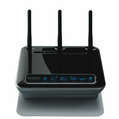| |
Wireless Technology
802.11a has a speed up to 54 Mbps and
operates at 2.4 GHz or 5 Ghz
802.11b has a speed up to 11 Mbps and
operates at 2.4 GHz
802.11g has a speed up to 54 Mbps
and operates at 2.4 GHz
802.11n has a speed up to 540 Mbps allows
channel bonding and operates at 2.4 GHz or 5 GHz
Wi-Max - 802.16 (78 Mbps)
802.11b (standard for Wi-Fi),
802.11g and Bluetooth all operate at 2.4
GHz.
802.11 (IEEE 802.11) - the original standard for wireless networks operates at a maximum speed of 2 Mbps.
802.11i is the best means of securing wireless protection - it is also known as WPA2
802.11i = WPA2 (with AES is the best)
802.15.1 = Bluetooth - 720 kbps - 1 Mbps
WPA PEAR - support users authenticating with encrypted usernames and passwords.
The WPA protocol implements the majority of the IEEE 802.11i standard. The Wi-Fi Alliance intended WPA as
an intermediate measure to take the place of WEP pending the preparation of 802.11i. Specifically, the Temporal Key Integrity
Protocol (TKIP), was brought into WPA. TKIP could be implemented on pre-WPA wireless network interface cards.
WPA2 has replaced WPA; WPA2 requires testing and certification by the Wi-Fi Alliance. WPA2 implements
the mandatory elements of 802.11i. In particular, it introduces CCMP, a new AES-based encryption mode with mathematically proven
security. WPA2 certification is mandatory for all new devices to bear the Wi-Fi trademark.
802.11n is a recent amendment which improves upon the previous 802.11 standards by adding multiple input
multiple output (MIMO) and many other newer features.
In radio, multiple-input and multiple-output, or MIMO is the use of multiple
antennas at both the transmitter and receiver to improve communication performance. It is one of several forms of
smart antenna technology.
MIMO technology has attracted attention in wireless communications, because it offers significant increases
in data throughput and link range without additional bandwidth or transmit power.
Definition: Wireless access points (APs or WAPs) are specially configured nodes on wireless local area
networks (WLANs). Access points act as a central transmitter and receiver of WLAN radio signals.
Range of wireless networks cab be determined by a combination of factors such as wireless NIC card,
wireless access point, antennas and wireless router capabilities.
Definition of wireless n.
The key to 802.11n is the use of multiple antennas, which improve distance, reliability and speed. Up to
four data streams can be sent simultaneously using 20MHz or 40MHz channels, providing a theoretical maximum data
rate of 600 Mbps..
The Belkin N1 wireless router is supposed to support 300 Mbps maximum network bandwidth per the Draft N standard
and a range up to 1,400 feet (450 m) using its 3
built-in antennas.

 While the definition above states 600 Mbps, both Belkin and Linksys are only claiming that can achieve a current
maximum speed of 300 Mbps.
Definition: Wireless Router. A network device that combines a router, switch and access point (base
station) in one box. Wireless routers provide a convenient way to connect a small number of wired and
any number of wireless computers to the Internet. By comparison none wired routers are not as flexible.
While the definition above states 600 Mbps, both Belkin and Linksys are only claiming that can achieve a current
maximum speed of 300 Mbps.
Definition: Wireless Router. A network device that combines a router, switch and access point (base
station) in one box. Wireless routers provide a convenient way to connect a small number of wired and
any number of wireless computers to the Internet. By comparison none wired routers are not as flexible.
The current highest speed wireless routers as of 2018 are 802.11ac wireless routers which have 8 160MHz 256-QAM channels.
Each channel is capable of operating at 866.7Mbps which equals a total of 6,933Mbps or just under 7Gbps.
Below is a picture of one of the more expensive wireless router that I could find as of 2018 which is the
Netgear Nighthawk Pro Gaming XR700 Wireless Router – 6 port - 2.4 GHz - 5 GHz - 60 GHz - Gigabit Ethernet -
802.11b/a/g, 10 Gigabit Ethernet - 802.11n/ac/ad which operates at 1.7GHz and has a Quad core Processor.
This wireless router lists for $500.00


|
|
